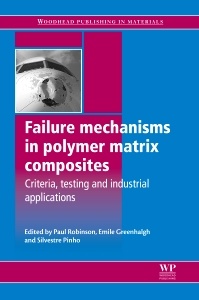Failure Mechanisms in Polymer Matrix Composites Criteria, Testing and Industrial Applications Woodhead Publishing Series in Composites Science and Engineering Series
Coordonnateurs : Robinson Paul, Greenhalgh Emile, Pinho Silvestre

Contributor contact details
Part I: Failure mechanisms
Chapter 1: Progress in failure criteria for polymer matrix composites: A view from the first World-Wide Failure Exercise (WWFE)
Abstract:
1.1 Introduction
1.2 Aims of the first World-Wide Failure Exercise (WWFE)
1.3 Setting up test problems
1.4 Description of available models
1.5 Design problems solved
1.6 Gaps identified
1.7 Current activities
1.1 Conclusions
1.2 Acknowledgements
Chapter 2: Manufacturing defects as a cause of failure in polymer matrix composites
Abstract:
2.1 Introduction and basic requirements
2.2 Sources of variability and defects in composite mouldings
2.3 Impact of residual stresses and geometrical distortions on performance
2.4 Impact of voidage and delaminations on inplane and out-of-plane properties
2.5 Impact of misaligned, wavy and wrinkled reinforcements on in-plane and out-of-plane properties
2.6 Approaches to minimize the impact of manufacturing defects
2.7 Future trends
Chapter 3: Low- and medium-velocity impact as a cause of failure in polymer matrix composites
Abstract:
3.1 Introduction
3.2 Impact damage
3.3 Impact response
3.4 Strength and stability after impact
3.5 Computational models
3.6 Future trends
3.7 Sources of further information and advice
Chapter 4: Structural integrity of polymer matrix composite panels in fire
Abstract:
4.1 Introduction
4.2 Temperature distribution
4.3 Material behavior at elevated temperature
4.4 Global buckling
4.5 Skin wrinkling of sandwich panels
4.6 Plastic micro-buckling
4.7 Other aspects of structural integrity in fire
Chapter 5: Testing the toughness of polymer matrix composites
Abstract:
5.1 Introduction
5.3 Translaminar fracture toughness testing
5.4 Ply-Level Fracture Toughness Testing
5.5 Conclusions
Chapter 6: Testing the strength and stiffness of polymer matrix composites
Abstract:
6.1 Introduction
6.2 Key issues
6.3 In-plane testing
6.4 Out-of-plane testing
6.5 Biaxial in-plane testing
6.6 Triaxial testing
6.7 Concluding comments
Chapter 7: Fibre-dominated compressive failure in polymer matrix composites
Abstract:
7.1 Introduction
7.2 The physics of fibre kinking in unidirectional plies
7.3 Compressive failure in two-dimensional woven composites
7.4 Compressive failure in recycled composites
7.5 Conclusions
7.6 Acknowledgement
Part II: Failure mechanisms in specific applications
Chapter 8: Considerations of failure mechanisms in polymer matrix composites in the design of aerospace structures
Abstract:
8.1 Introduction
8.2 Design considerations
8.3 Structural considerations
8.4 Designing for damage in composites
8.5 Materials-based approaches
8.6 Structures-based approaches
8.7 Conclusions
Chapter 9: Failure of polymer matrix composites in defence applications
Abstract:
9.1 Introduction
9.2 Ballistic damage of composite structures
9.3 Implications for preventing failure
9.4 Trends in modeling composite failures in military applications
Chapter 10: Failure of polymer matrix composites in marine and off-shore applications
Abstract:
10.1 Introduction
10.2 Material types
10.3 Failure of composite materials for surface vessels
10.4 Failure of composite materials for underwater structures
10.5 Modelling failure
10.6 Future trends
Chapter 11: Recycling issues in polymer matrix composites
Abstract:
11.1 Introduction
11.2 The problems of reuse in polymer composites
11.3 Plastic waste disposal into other materials
11.4 Mechanical recycling of polymeric matrix composites
11.5 Recovery techniques
11.6 Properties of recovered fibres
11.7 Future strategies for making polymer matrix composites more recyclable
11.8 Conclusions
11.11 Appendix: abbreviations
Chapter 12: Failure of polymer matrix composites (PMCs) in automotive and transportation applications
Abstract:
12.1 Introduction
12.2 Polymer matrix composites (PMCs) used in automotive and road transportation applications
12.3 Scope of the chapter
12.4 Common in-service conditions causing failure
12.5 Sheet molding compound (SMC) composites
12.6 Polymer matrix composites (PMCs) for crashworthy structures
12.7 Implications of preventing failure
12.8 Future trends
Chapter 13: Environmental induced failure in fibre-reinforced plastics
Abstract:
13.1 Introduction
13.2 Chemical agents and degradation mechanisms
13.3 Environmental conditioning and testing
13.4 Modelling and predictive analysis
13.5 Optimising chemical resistance and prevention of failure
13.6 Conclusions and future trends
13.7 Sources of further information and advice
13.8 Acknowledgements
13.10 Appendix: standards
Index
Dr Emile Greenhalgh works in the Department of Aeronautics at Imperial College London, UK. He is widely renowned for his expertise on the failure mechanics of composite materials.
Dr Silvestre Pinho works in the Department of Aeronautics at Imperial College London, UK. He is widely renowned for his expertise on the failure mechanics of composite materials.
- Discusses various failure mechanisms, including manufacturing defects
- Reviews testing techniques and modelling methods for predicting potential failure
- Investigates failure in aerospace, automotive, defence, marine and off-shore applications
Date de parution : 01-2012
Ouvrage de 464 p.
15.5x23.2 cm



